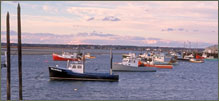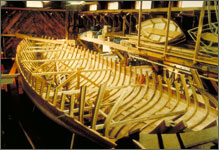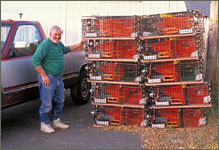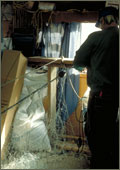Occupational Traditions – Maritime Traditions
New Hampshire's 18 miles of Atlantic Ocean coastline is along its southeastern border, sandwiched right in between Maine and Massachusetts. During the summer, tourists flock to the beaches of Hampton and Rye, the Isles of Shoals, and to the historic city of Portsmouth to relax and enjoy the sea air.

Fishing boats off the coast of Rye, NH
But New Hampshire's short stretch of coast is also a working coastline. Portsmouth, Hampton, and Rye all have commercial fishing harbors. They provide facilities for over 400 gill netters, lobster fishermen, and trawlers. The environmental face of the sea extends to the Great Bay west of Portsmouth, creating favorable conditions for oystering and smelt fishing.
The boat harbors on the New Hampshire seacoast operate year round. Winter is milder than elsewhere in the state but blustery Nor'easters (severe storms that travel up the coast) are a possibility that people who work on the sea need to be prepared for at a moment's notice.
There is a long history of ship and boat building on the New Hampshire seacoast. Large ocean going ships have been built in the Portsmouth area since the 1600s, when the wood from New England forests where brought down by river. The tall white pines of northern New Hampshire were once reserved exclusively for the masts of the King of England's ships.

Boat under construction at
Jeff Fogman's boat shop
in Barrington, NH.
In 1800, the Portsmouth Naval Shipyard was established to build large naval warships and submarines. Today, their work mostly involves repairing submarines. Though the materials have changed over the years, working on seagoing vessels requires skill that is learned in a traditional way-from one person to another.
Recreational boat making on the New Hampshire coast is also a strong tradition. The dory- a small wooden rowboat-is the most popular style. The local type of dory, the Piscataqua River Wherry, is named after the river that divides New Hampshire and Maine at the coast. The gundalow was a particular style of boat developed to transport goods on the rivers of New Hampshire but is seldom made anymore. Canoe building for the lakes and rivers is more common.

Robert Littlefield with
some of his lobster traps.
Making smaller wooden boats requires great skill and builders often apprentice with a master builder to learn the trade. Several boat builders in New Hampshire, including Jeff Fogman and Gordon Swift did their apprenticeship with master builder Bud McIntosh. Gordon Swift has in turn advised a group of Sanborn High School students who with their teacher, E.J. Gaudette, created "Project Wherry, " which incorporated the traditional skills of boat-building into the curriculum.
To make a living on the sea requires tenacity, skill, and a love for the ocean. The knowledge required is so varied, that it is takes years to master. Traditional occupations like fishing, net making and lobstering are often passed down within families.

Jim Antanavich
puts the
finishing touches
on a gill net.
The Robichaud and Antanovitch, families have been around the sea for generations. Jim Antanavich Jr., operates a gill net making company called Shelbo's Net Profit in Seabrook, NH with five family members. At one time nets were made from a type of cotton, but these days they are almost all made from a clear plastic fiber called monofilament. Though durable, the plastic line is much harder to work with, especially to repair a hole.
Lobstering is a seasonal occupation and relatively few people are full-time lobstermen. Wooden traps have given way in the past 15 years to wire traps, which are easier to build and maintain.
For more information on maritime activities off the coast of New Hampshire visit the University of New Hampshire's Sea Grant website!
New Hampshire State Council on the Arts
19 Pillsbury Street - 1st Floor, Concord, NH 03301


